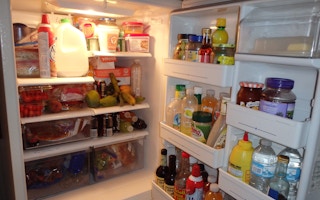Old forms of refrigerant gases known as hydrofluorocarbons (HFCs) – used as foam blowing agents and aerosol propellants in air conditioning, refrigeration, heat pumps and similar technologies – are being phased out due to their high global warming potential.
However some of their replacements are now being shown to potentially cause other problems down the line.
Most countries have signed the Kigali Amendment to the Montreal Protocol to stop the decay of the ozone layer, and agreed to reduce HFCs’ production and use.
This has the potential to avoid as much as 0.4°C of global warming by 2100, since they have a global warming potential (GWP) ranging from 53 to almost 15,000. For comparison, carbon dioxide (CO2) has a GWP of 1.
Natural substitutes for HFCs exist. They include propane (GWP 3) for chillers, ammonia (GWP 0) for industrial applications, CO2 for commercial refrigeration and new promising technologies such as water (GWP 0) for server cooling, or air (GWP 0) for temperatures down to -160 °C.
But the most prevalent low GWP refrigerant currently expected to be used in the future are hydrofluoroolefins (HFOs).
Refrigerant producers often advertise HFOs as climate friendly and safe for the environment.
These gases have the proper freezing and boiling points to be useful for refrigeration at common temperatures. They also show promise as blowing agents, i.e. in production of insulation foams, food industry, construction materials, and others.
There could be trouble ahead
Warnings now suggest that using HFOs could create a range of new problems in the future as their products degrade. An issue made worse by the fact they are not regulated in Australia under the Ozone Protection and Synthetic Greenhouse Gas Management (OSGG) Programme.
In a new study of the environmental impact of HFOs, the German Environment Agency (UBA) concluded that HFOs used as refrigerants, foam blowing agents and aerosol propellants “should be replaced by more sustainable solutions with halogen-free substances” such as natural refrigerants.
This is because, when released into the atmosphere by leaks or improper end-of-life disposal of a unit, HFOs break down into trifluoroacetic acid (TFA). TFA is already widely used in organic chemistry for various purposes, and so its lifecycle has been studied by the German scientists.
They identify that TFA is a highly persistent (long-lived) substance which represents a danger to the environment and humans, as it has so far unknown consequences for ecosystems and health.
Atmospheric TFA descends to earth in rainfall, and the report notes that higher levels of TFA have been found in rainwater. It is not readily biodegradable unless in anaerobic digester conditions and may be toxic to aquatic life at certain concentrations. According to the UBA, it is “classified as hazardous to water”.
TFA cannot be removed by current water treatment technology. It accumulates in local lakes, freshwater and soils, and therefore drinking water of humans and animals.
For this reason, the UBA says that the use of HFOs as substitutes for HFCs “must be regarded as problematic.”
The report concludes with a demand to immediately stop the selling of all synthetic refrigerants and switch to natural refrigerants only.
“While the environmental effects of TFA are considered to be negligible over the next few decades, potential longer-term impacts require further evaluations due to the environmental persistence of TFA, and to the uncertainty in growth due to future uses of HFOs,” the report stated.
“Releasing chemicals that can last for generations in the environment, especially when there is an uncertainty about the environmental and health impacts, must be avoided when alternatives are available.”
There are concerns that, once ingested, these chemicals end up in thyroids and livers.
Energy efficiency consultant Derek Harbison said, “as we migrate over to these systems, we need to be making a choice as to what sort of systems we are using and the effect that they have on the environment.”
Why air conditioning is a climate flashpoint
Air conditioning systems out number people in Australia by around two to one.
Besides these, there are fridges, car air conditioning, and increasingly common, heat pumps.
The UN Environment Programme (UNEP) and the International Energy Agency (IEA) have urged the world to focus on improved cooling in post-pandemic recovery plans.
Doubling the energy efficiency of air conditioning by 2050 would reduce the need for 1,300 gigawatts of additional electricity generation capacity to meet peak demand – the equivalent of all the coal-fired power generation capacity in China and India in 2018, they say.
Worldwide, there are 3.6 billion appliances in use now, and by 2050 this is projected to have risen to 14 billion. Doubling their energy efficiency could save up to US$2.9 trillion by 2050 in reduced electricity generation, transmission and distribution costs alone.
As the need for cooling rises in step with world temperatures, energy-efficient, climate-friendly appliances are critical to reaching Paris Agreement goals.
Coordinated international action on energy-efficient, climate-friendly cooling could avoid as much as 460 billion tonnes of greenhouse gas emissions – roughly equal to eight years of global emissions at 2018 levels – over the next four decades, according to their Cooling Emissions and Policy Synthesis Report.
Their suggested policy options include the promotion of building codes and other considerations to reduce demand for refrigerant and mechanical cooling – including the integration of district and community cooling into urban planning, improved building design, the use of green roofs, white paints on roofs and tree shading.
They also call for campaigns to stop environmentally harmful product dumping and point out that sustainable cold-chains are also vital to both reduce food loss – a major contributor to greenhouse gas emissions – and reduce emissions from cold chains.
This story was published with permission from The Fifth Estate.








